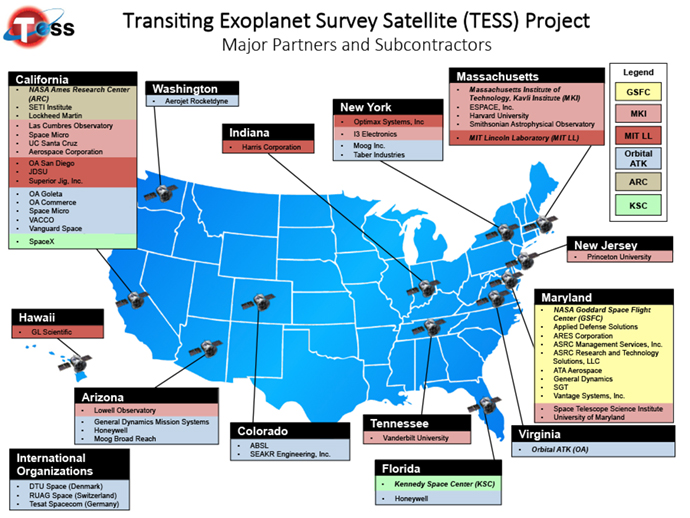This website is kept for archival purposes only and is no longer updated.
Mission History
The Transiting Exoplanet Survey Satellite (TESS) is a NASA-based mission, selected in 2013 as an astrophysics mission in the Explorers Program. TESS has a long history, beginning as a small, privately funded mission in 2006. It started with financial backing from private companies, including Google, the Kavli Foundation, and donors at Massachusetts Institute of Technology (MIT). This all changed in 2008, when MIT proposed TESS as an official NASA astrophysics mission, re-structuring it as a Small Explorer (SMEX) Class Mission. After not being selected in this competitive process for NASA resources, TESS proposed again in 2010 as a NASA Explorer (EX) Class Mission. TESS is the first of this new classification of Explorer missions. In 2013, TESS was successful in the proposal process and NASA began the development of the project. MIT's Kavli Institute of Technology for Astrophysics (MKI) has remained as an original partner in the current TESS mission, joining NASA in the next search for new worlds.
TESS's HISTORY
- 2006: Conceived as a privately-funded small mission
- Kavli Foundation support
- Google seed funding
- MIT private donors
- 2007: Re-structured as a possible mission of opportunity
- 2008: Proposed as a NASA Small Explorer (SMEX) Class Mission
- Selected for phase A as 1 of 3 astrophysics missions
- 2010: Re-proposed as a NASA Explorer (EX) Class Mission
- Selected for Phase A as 1 of 2 astrophysics missions
- 2013: Approved for formulation
- 2014: Approved for implementation
- 2015: Completed Critical Design Review (CDR)
TESS has a number of partners supporting the current mission. They include:
- Massachusetts Institute of Technology's Kavli Institute for Astrophysics and Space Research (MKI); MIT Lincoln Laboratory
The principal investigator, development of the mission's instrument, and science center and analysis
- NASA's Goddard Space Flight Center (GSFC)
Manages the mission, systems engineering, safety and mission assurance, and communications & public engagement
- Orbital ATK
Provides the spacecraft, the observatory integration & testing, and the mission operation center
- MIT Lincoln Laboratory (LL)
Provides development of the instrument and instrument engineering support
- NASA's Ames Research Center (ARC)
Develops the science pipeline
- Harvard-Smithsonian Center for Astrophysics
Oversees the mission follow-up program and science center
- Space Telescope Science Institute
Administers the mission's science archives

